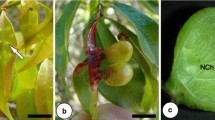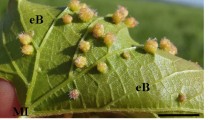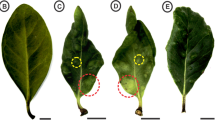Abstract
Key message
The origin of xylem cells, intracellular variation, and gall position relative to the host plant organ are related to mechanisms that positively compensate hydraulic conductivity in galls.
Abstract
Gall position in its host organ may be determinant for the new patterns of xylem differentiation. Leaf galls may be attached to the host leaf by a peduncle, as the extralaminar galls, or may develop in a morphological continuum with their host organ, as the intralaminar galls. Due to these two distinct positions and the related patterns of cell differentiation, gall vascular cells and tissues may vary in area and size, which were investigated in the structural features of the vessel elements in galls and in their connections with their host leaflets in three gall morphotypes associated to Inga ingoides. Also, as phytohormones orchestrate the differentiation of vascular cells, the sites of accumulation of auxins and cytokinins were detected by histochemical techniques. Besides aspects of cell differentiation, cytometric and histometric xylem features, as well as the relative water content were evaluated looking for compensatory mechanisms related to hydraulic status of the galls and the gall constriction hypothesis. The detection of auxins was related with the differentiation of new vascular cells. The origin of xylem cells, intracellular variation, and gall position relative to the host plant organ are related to mechanisms that positively compensate the hydraulic conductivity in galls. Extralaminar galls develop as appendages of adventitious origin, which theoretically imply in rupture with the host leaf ontogenetical pattern. Based on the fact that gall position influences xylem cell features, the gall-constriction hypothesis was revisited with leaflet galls as models of study, but was corroborated just for the intralaminar galls.







Similar content being viewed by others
Availability of data and materials
The data and material can be made available as needed.
References
Aloni R (1987) Differentiation of vascular tissues. Ann Rev Plant Physiol 38:179–204
Aloni R (2001) Foliar and axial aspects of vascular differentiation-hypotheses and evidence. J Plant Growth Regul 20:22–34. https://doi.org/10.1007/s003440010001
Aloni R (2013) Role of hormones in controlling vascular differentiation and the mechanism of lateral root initiation. Planta 238:819–830. https://doi.org/10.1007/s00425-013-1927-8
Aloni R (2015) Ecophysiological implications of vascular differentiation and plant evolution. Trees 29:1–16. https://doi.org/10.1007/s00468-014-1070-6
Aloni R, Zimmermann MH (1983) The control of vessel size and density along the plant axis - a new hypothesis. Differentiation 24:203–208. https://doi.org/10.1111/j.1432-0436.1983.tb01320.x
Aloni R, Zimmermann MH (1984) Length, width, and pattern of regenerative vessels along strips of vascular tissue. Bot Gaz 145(1):50–54
Aloni R, Pradel KS, Uilrich CI (1995) The three-dimensional structure of vascular tissues in Agrobacterium tumefaciens-induced crown galls and in the host stems of Ricinus communis L. Planta 196:597–605. https://doi.org/10.1007/BF00203661
Aranda-Rickert A, Rothen C, Diez P, González AM, Marazzi B (2017) Sugary secretions of wasp galls: a want-to-be extrafloral nectar? Ann Bot 120(5):765–774. https://doi.org/10.1093/aob/mcx075
Arduin M, Kraus JE (2001) Anatomia de galhas de ambrosia em folhas de Baccharis concinna e Baccharis dracunculifolia (Asteraceae). Rev Bras Bot 24:63–72
Bedetti CS, Modolo LV, Isaias RMS (2014) The role of phenolics in the control of auxin in galls of Piptadenia gonoacantha (Mart) MacBr (Fabaceae: Mimosoideae). Biochem Syst Ecol 55:53–59. https://doi.org/10.1016/j.bse.2014.02.016
Bedetti CS, Bragança GP, Isaias RMS (2017) Influence of auxin and phenolic accumulation on the patterns of cell differentiation in distinct gall morphotypes on Piptadenia gonoacantha (Fabaceae). Aust J Bot 65:411–420. https://doi.org/10.1071/BT16257
Bedetti CS, Jorge NC, Trigueiro FCG, Bragança GP, Modolo LV, Isaias RMS (2018) Detection of cytokinins and auxin in plant tissues using histochemistry and immunocytochemistry. Biotech Histochem 93:149–154. https://doi.org/10.1080/10520295.2017.1417640
Buckley TN (2015) The contributions of apoplastic, symplastic and gas phase pathways for water transport outside the bundle sheath in leaves. Plant Cell Environ 38:7–22. https://doi.org/10.1111/pce.12372
Bukatsch F (1972) Bemerkungen zur Doppelfärbung Astrablau-Safranin. Mikrokosmos 61:255
Carneiro RGS, Castro AC, Isaias RMS (2014) Unique histochemical gradients in photosynthesis-deficient plant gall. South Afr J Bot South 92:94–104. https://doi.org/10.1016/j.sajb.2014.02.011
Carneiro RGS, Isaias RMS, Moreira ASFP, Oliveira DC (2017) Reacquisition of new meristematic sites determines the development of a new organ, the Cecidomyiidae gall on Copaifera langsdorffii Desf. (Fabaceae). Front Plant Sci 8:1622. https://doi.org/10.3389/fpls.2017.01622
Dias GG, Ferreira BG, Moreira GR, Isaias RMS (2013) Developmental pathway from leaves to galls induced by a sap-feeding insect on Schinus polygamus (Cav.) Cabrera (Anacardiaceae). An Acad Bras Cienc 85(1):187–200
Dietrich A, Wolf T, Eimert K, Schröder MB (2010) Activation of gene expression during hypersensitive response (HR) induced by auxin in the grapevine rootstock cultivar ‘Börner’. Vits 49(1):15–21. https://doi.org/10.5073/vitis.2010.49.15-21
Dolzblasz A, Banasiak A, Vereecke D (2018) Neovascularization during leafy gall formation on Arabidopsis thaliana upon Rhodococcus fascians infection. Planta 247(1):215–228. https://doi.org/10.1007/s00425-017-2778-5
Evert RF (2013) Anatomia das plantas de Esau: meristemas, célula e tecidos do corpo da planta: sua estrutura e função e desenvolvimento. Blucher, São Paulo
Fahn A (1990) Plant anatomy. Pergamon Press, Oxford
Ferreira BG, Isaias RMS (2013) Developmental stem anatomy and tissue redifferentiation induced by a galling Lepidoptera on Marcetia taxifolia (Melastomataceae). Bot 91:752–760. https://doi.org/10.1139/cjb-2013-0125
Ferreira BG, Falcioni R, Guedes LM, Avritzer SC, Antunes WC, Souza LA, Isaias RM (2017a) Preventing false negatives for histochemical detection of phenolics and lignins in PEG-embedded plant tissues. J Hitochem Cytochem 65(2):105–116. https://doi.org/10.1369/2F0022155416677035
Ferreira BG, Avritzer SC, Isaias RMS (2017b) Totipotent nutritive cells and indeterminate growth in galls of Ditylenchus gallaeformans (Nematoda) on reproductive apices of Miconia. Flora 227:36–44. https://doi.org/10.1016/j.flora.2016.12.008
Ferreira BG, Freitas MSC, Bragança GP, Moreira ASFP, Carneiro RGS, Isaias RMS (2019) Enzyme-mediated metabolism in nutritive tissues of galls induced by Ditylenchus gallaeformans (Nematoda: Anguinidae). Plant Biol 21(6):1052–1062. https://doi.org/10.1111/plb.13009
Feild TS, Brodribb TJ (2013) Hydraulic tuning of vein cell microstructure in the evolution of angiosperm venation networks. New Phytol 199:720–726. https://doi.org/10.1111/nph.12311
França MGC, Prados LMZ, Lemos-Filho JP, Ranieri BD, Vale FHA (2012) Morphophysiological differences in leaves of Lavoisiera campos-portoana (Melastomataceae) enhance higher drought tolerance in water shortage events. J Plant Res 125:85–92. https://doi.org/10.1007/s10265-011-0416-z
Fukuda H (1997) Tracheary element differentiation. Plant Cell 9:1147–1156
Fukuda H, Komamine A (1980) Direct evidence for cytodifferentiation to tracheary elements without intervening mitosis in a culture of single cells isolated from the mesophyll of Zinnia elegans. Plant Physiol 65:61–64. https://doi.org/10.1104/pp.65.1.61
Guzicka M, KarolewskiGiertych PMJ (2017) Structural modification of Quercus petraea leaf caused by Cynips quercusfolii—histological study of galls. J Plant Interact 12(1):7–13. https://doi.org/10.1080/17429145.2016.1269214
Hori K (1992) Insect secretion and their effect on plant growth, with special reference to hemipterans. In: Shorthouse JD, Rohfritsch O (eds) Biology of insect-induced galls. Oxford University Press, New York, pp 157–170
Isaias RMS, Oliveira DC, Carneiro RGS (2011) Role of Euphalerus ostreoides (Hemiptera: Psylloidea) in manipulating leaflet ontogenesis of Lonchocarpus muehlbergianus (Fabaceae). Bot 89:581–592. https://doi.org/10.1139/b11-048
Isaias RMS, Carneiro RGS, Oliveira DC, Santos JC (2013) Illustrated and annotated checklist of Brazilian gall morphotypes. Neotrop Entomol 42:230–239. https://doi.org/10.1007/s13744-013-0115-7
Isaias RMS, Oliveira DC, Carneiro RGS, Kraus JE (2014) Developmental anatomy of galls in the neotropics, arthropods stimuli versus host plant constraints. In: Fernandes GW, Santos JC (eds) Neotropical insect galls. Springer, Netherlands, pp 15–34
Jeffrey EC (1919) The structure of wood, 2nd edn. Adam and Charles Black, London
Johansen DA (1940) Plant microtechnique. McGraw-Hill Book Company, New York
Karnovsky MJ (1965) A formaldehyde-glutaraldehyde fixative of high osmolarity for use in electron microscopy. J Cell Sci 27:137–138
Kraus JE, Arduin M (1997) Manual básico de métodos em morfologia vegetal. EDUR, Seropédica
Kraus JE, Arduin M, Venturelli M (2002) Anatomy and ontogenesis of hymenopteran leaf galls of Struthanthus vulgaris Mart. (Loranthaceae). Rev Brasil Bot 25(4):449–458
Leopold AC, Plummer TH (1961) Auxin–phenol complexes. Plant Physiol 36:589–592
Matsumuoto-Kitano M, Kusumoto T, Tarkowski P, Kinoshita-Tsujimura VK, Miyawaki K, Kakimoto T (2008) Cytokinins are central regulators of cambial activity. PNAS 105(50):20027–20031. https://doi.org/10.1073/pnas.0805619105
Mazur E, Benková E, Friml J (2016) Vascular cambium regeneration and vessel formation in wounded inflorescence stems of Arabidopsis. Sci Rep 6:33754. https://doi.org/10.1038/srep33754
Milioni D, Sado PE, Stacey NJ, Domingo C, Roberts K, McCann MC (2001) Differential expression of cell-wall-related genes during the formation of tracheary elements in the Zinnia mesophyll cell system. In: Carpita NC, Campbell M, Tierney M (eds) Plant cell walls. Springer, Dordrecht
Nogueira RM, Costa EC, Silva JS, Isaias RMS (1908) Structural and histochemical profile of Lopesia sp. Rübsaamen 1908 pinnula galls on Mimosa tenuiflora (Willd.) Poir. in a Caatinga environment. Hoehnea 45(2):314–322. https://doi.org/10.1590/2236-8906-80/2017
O’Brien TP, McCully ME (1981) The study of plant structure principles and selected methods. Termarcarphi, Melbourne
Paiva JGA, Fank-de-Carvalho SM, Magalhães MP, Graciano-Ribeiro D (2006) Verniz vitral incolor 500®: uma alternativa de meio de montagem economicamente viável. Acta Bot Bras 20:257–264
Sachs T (1981) The control of patterned differentiation of vascular tissues. Adv Bot Res 9:151–262. https://doi.org/10.1016/S0065-2296(08)60351-1
Sachs T (2000) Integrating cellular and organismal aspects of vascular differentiation. Plant Cell Physiol 41:649–656. https://doi.org/10.1093/pcp/41.6.649
Schuetz M, Smith R, Ellis B (2013) Xylem tissue specification, patterning, and differentiation mechanism. J Exp Bot 64(1):11–31. https://doi.org/10.1093/jxb/ers287
Suzuki AYM, Bedetti CS, Isaias RMS (2015) Detection and distribution of cell growth regulators and cellulose microfibrils during the development of Lopesia sp. galls on Lonchocarpus cultratus (Fabaceae). Bot 93:435–444. https://doi.org/10.1139/cjb-2015-0012
Touchstone JC (1992) Practice of thin layer chromatography. Wiley, New York
Ullrich CL, Aloni R (2000) Vascularization is a general requirement for growth of plant and animal tumours. J Exp Bot 51(353):1951–1960. https://doi.org/10.1093/jexbot/51.353.1951
Ursache R, Nieminen K, Helariutta Y (2013) Genetic and hormonal regulation of cambial development. Physiol Plant 147:36–45. https://doi.org/10.1111/j.1399-3054.2012.01627.x
Wetmore R, Rier J (1963) Experimental induction of vascular tissues in callus of angiosperms. Am J Bot 50:418–430
Ye Z-H (2002) Vascular tissue differentiation and pattern formation in plants. Annu Rev Plant Biol 53:183–202. https://doi.org/10.1146/annurev.arplant.53.100301.135245
Acknowledgements
We thank Fundação de Amparo à Pesquisa do Estado de Minas Gerais (FAPEMIG) for financial support, CAPES for the doctoral scholarship provided to GPB (88882.184378/2018-01), and CNPq for the researcher scholarship and grant to RMSI (304535/2019-2).
Funding
The present study was supported by Fundação de Amparo a Pesquisa do Estado de Minas Gerais (FAPEMIG), Coordenação de Aperfeiçoamento de Pessoal de Nível Superior financial (CAPES) and Conselho Nacional de Desenvolvimento Científico e Tecnologico (CNPq).
Author information
Authors and Affiliations
Corresponding author
Ethics declarations
Conflict of interest
The authors declare that they have no conflict of interest.
Additional information
Communicated by Feau.
Publisher's Note
Springer Nature remains neutral with regard to jurisdictional claims in published maps and institutional affiliations.
Rights and permissions
About this article
Cite this article
Bragança, G.P.P., Freitas, M.d.C. & Isaias, R.M.d. The influence of gall position over xylem features in leaflets of Inga ingoides (Rich.) Willd. (Fabaceae: Caesalpinioideae). Trees 35, 199–209 (2021). https://doi.org/10.1007/s00468-020-02027-1
Received:
Accepted:
Published:
Issue Date:
DOI: https://doi.org/10.1007/s00468-020-02027-1




